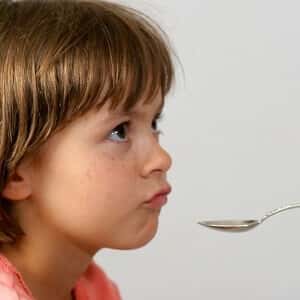
When a young child catches a cold–which they do far too frequently–parents want to do something to ease the suffering. Watching a child struggle with a drippy nose or listening to a nagging nighttime cough is torture for parents.
Moms and Dads should think twice, or maybe three times, before rushing to the drugstore for an over-the-counter cold remedy. Even medicines that are labeled for children have not, for the most part, been proven effective for little ones. And they do present possible risks.
Earlier this year, the Centers for Disease Control and Prevention announced the results of a study showing that over a two-year time span, more than 1,500 babies and toddlers were taken to emergency rooms because of bad reactions to OTC cough or cold medicines. Three babies actually died.
The deaths were linked to dangerously high blood levels of pseudoephedrine, a decongestant common in cold remedies. Pseudoephedrine is available without a prescription, although now it is kept behind the counter and customers have to ask the pharmacist and sign for it.
Giving kids under two years of age any nonprescription medicine poses serious risks. Parents should do this only when the child’s doctor recommends a product and gives specific instructions for its use, including the dose.
Even when a doctor or nurse makes a recommendation, be extra careful about checking the dose and administering the medicine. Doctors may need to estimate the right dose based on the child’s weight, and these calculations can be subject to error.
Even when the dose is correct, administering it can be a challenge. Anyone who has ever tried to get a two-year-old to swallow medicine she doesn’t want can attest that this can turn into a dreadful scene. The kid screams, the parent fusses, the medicine is spread all around, and there’s no good way to tell how much medicine actually gets into the youngster.
Parents should be very careful with both prescription and over-the-counter liquids. Liquid medicine doses may be expressed as teaspoons, but parents should resist the temptation to pull a spoon out of the kitchen drawer.
Studies have shown that most people use household spoons when they have to administer liquid medicine. Some have a hard time telling the difference between a teaspoon and a tablespoon. (There are three teaspoons in a tablespoon.)
Household spoons are not accurate measuring devices. Although a medical teaspoon contains exactly 5 milliliters, the spoon you use to stir your coffee might hold as little as 2 ml, and the one you use for your breakfast cereal might accommodate 10 ml.
Giving a child too little liquid antibiotic might not clear up an infection. But too much might result in side effects. That’s why we strongly recommend that parents use an oral syringe. It may look intimidating, but there is no way to put a needle on the end. The markings on the barrel are easy to read and the plunger allows a parent to suck a precise amount of medication into the syringe and to squirt it gently into a squirming infant’s mouth.
By the way, kids with colds usually do fine without medicine. Before giving the child any drug, check with his or her doctor.

